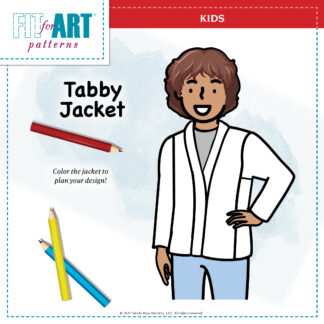
It’s time to introduce some more options included in the Carpe Diem Dress & Tunic pattern. This week we are looking at the Minty Fresh Carpe Diem Dress to demonstrate the steps for preparing and inserting the optional cap sleeve, back belt, and pleated hem vent.

Doesn’t this dress feel like a breath of fresh cool air? We need every bit of cool we can find or make this summer! The Minty Fresh Dress is made from our favorite rayon batik fabric in soft shades of green and blue. Carrie purchased the two primary fabrics – Gardenista Vine and Medora Flora in Mint – a year or two ago from our friends at SewBatik for a summer project. She found in her stash a leftover piece of Pinpoint Leaf in the color Flint that works with them for a slightly darker accent.
Cap Sleeve
The cap sleeve is added before the sleeveless side panel in this construction sequence. Prepare the cap sleeve by pressing each sleeve in half, wrong sides together, and running gathering stitches along the curve between the notches. After the shoulder seams are sewn, the cap sleeve is inserted into the front and back, matching the notches and circles first and then gathering the stitches to fit.



Carrie decided to add flat piping into the side seams to accent the lines of this dress, so it was prepared and inserted next. The Pinpoint Leaf flat piping is basted to each front and back side seam from the hem to the notches.

Sleeveless Side and Back Belt

The underarm curve of the sleeveless side panel is first finished with a typical facing, as you see here. Then, the side panel is ready to be inserted by sewing the front and back side seams. Take the time to baste those seams at the first pass and put the garment on to check the fit.

The back belt option is great for adding a little shaping through the waist area. The belt pattern is sized to insert the belt into the front side seams; for less cinching, the belt could be inserted into the back side seams instead. In that case, the belt pieces can be cut several inches shorter (subtract the finished width of the side panel at the waist).
When adding a back belt, try the dress or tunic on after basting the side seams to mark the desired location of the belt. Open the side seams at the desired location, insert the belt, restitch the side seam, and try it on again. When satisfied with the fit and belt placement, restitch all side seams with a standard-length stitch.
Finally, clean finish the side seams from hem to hem, just as you would for a Carpe Diem with sleeves, but press the seam allowances out toward the front and back. Here you can see how all three layers came together in the armhole.


Pleated Hem Vent
Our method for adding a pleated hem vent is straight forward and very useful in a full-length Carpe Diem dress to allow freedom of movement. Carrie chose the Pinpoint Leaf fabric for the inside of the pleated vent for a little peek-a-boo contrast. The pleat insert is a simple rectangle, so be sure to mark the square at top center to ensure symmetrical placement.



Reinforce the center back seam from 2″ above the dot to the hem with fusible interfacing then sew the center back seam closed, stopping at the dot and back stitching. Stitch the two sides of the pleat insert to the open center back seam allowances, starting at least 1” above the dot. Clean finish those seams and then fold the pleat into place from the inside, matching the insert’s square to the center back seam; the pleat should be an equal depth to either side of the center back. Check your work from the front, then press the pleat into place and sew the top of the pleat closed through the two layers.

Lastly, anchor the pleat in place by topstitching an upside-down V emanating from the center back seam to the pleat fold through all layers.
Neckline Facings
For this dress, Carrie chose a keyhole opening in the back with a button and thread loop; accordingly, the center back seam is left open above the dot. The prepared front and back facings are sewn together at the shoulder seam and then sewn into the dress along the neckline and keyhole opening. After pressing the facing to the inside, Carrie handstitched the bottom inch of the back facings together below the keyhole opening.




The facings also create a tidy finish to the upper armhole area. Press the raw edges of the facing under and pin them into place, covering the side seams. We recommend hand sewing the facing into place for the prettiest and most flexible finish along this seam.
See a version of the Carpe Diem Dress with a back zipper instead of keyhole opening in the Peony Garden Dress.
Keep it Cool!
Carrie styled this dress to fit loosely for maximum air flow. She is looking forward to it being a cool addition to her wardrobe for the upcoming France retreat!

Have you made a cap sleeve or sleeveless Carpe Diem dress for summer? If so, we would love to see photos of your Carpe Diems. If not, we hope this inspires you to create a cap sleeve dress or tunic to wear now. There is still plenty of summer weather to come.
Happy Sewing, Carrie






